You’ll discover how to transform your bedroom into a lush retreat using strategic plant placement and design principles. From creating dramatic living walls to styling intimate plant corners, these nine decoration ideas combine form and function to enhance your sleep sanctuary. Whether you have a spacious master suite or a cozy urban bedroom, each technique can be scaled to fit your space while maintaining proper plant health and visual impact.
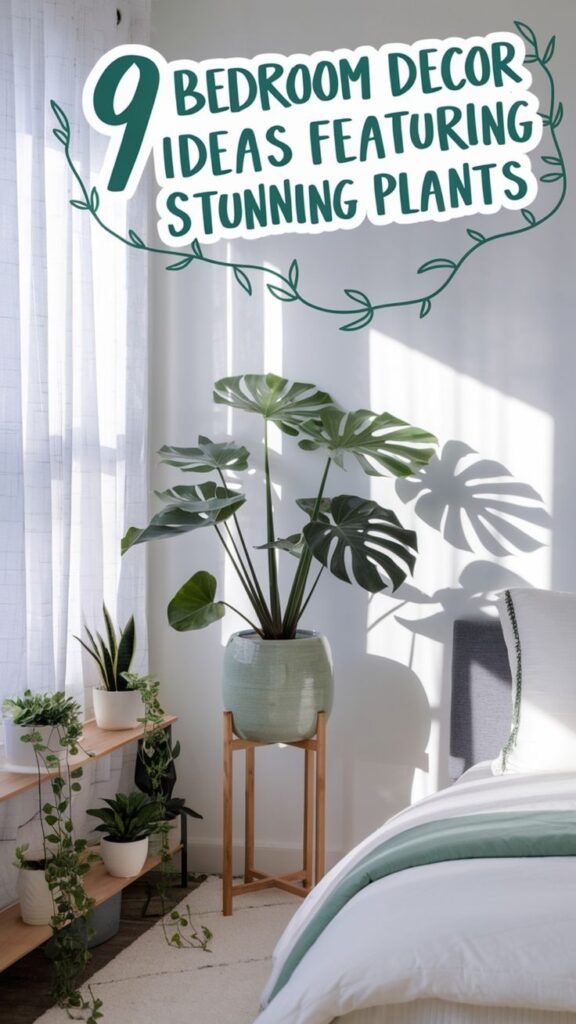
Contents
- 1 Create a Living Wall With Vertical Plant Displays
- 2 Style Your Nightstand With Air-Purifying Plants
- 3 Hang Cascading Plants From Ceiling Corners
- 4 Design a Plant-Filled Window Nook
- 5 Arrange a Tropical Paradise Behind Your Headboard
- 6 Transform Empty Corners With Floor-Standing Plants
- 7 Mix Plants With Mirrors for Visual Impact
- 8 Build a Bedside Plant Shelf Gallery
- 9 Layer Different Plant Heights for Depth and Drama
Create a Living Wall With Vertical Plant Displays

A living wall transforms an ordinary bedroom wall into a lush, vertical garden that serves as a stunning natural focal point. Vertical plant displays can range from simple hanging planters to elaborate modular systems with built-in irrigation, creating a tapestry of different plant varieties, colors, and textures.
These green walls not only maximize space in smaller bedrooms but also improve air quality and add a sense of tranquility to the sleeping environment.
- Light: Moderate to bright indirect light, avoiding direct afternoon sun that can scorch plants
- Water: Regular watering schedule, typically 2-3 times per week depending on system type
- Soil: Well-draining potting mix with good moisture retention
- Humidity: 40-60% relative humidity
- Temperature: 65-80°F (18-27°C)
- Growing Medium: Mix of traditional soil, coconut coir, or hydroponic systems
- Spacing: 6-12 inches between plants, depending on mature size
Regular maintenance ensures a thriving living wall display and prevents potential issues. Trim dead or yellowing foliage promptly to maintain aesthetics and prevent disease spread.
Rotate plants periodically if growth becomes uneven due to light exposure. Check the irrigation system weekly for clogs or leaks, and dust leaves monthly to maintain their ability to photosynthesize effectively.
Fertilize with a balanced, water-soluble fertilizer during the growing season, and inspect regularly for signs of pests or disease.
Style Your Nightstand With Air-Purifying Plants
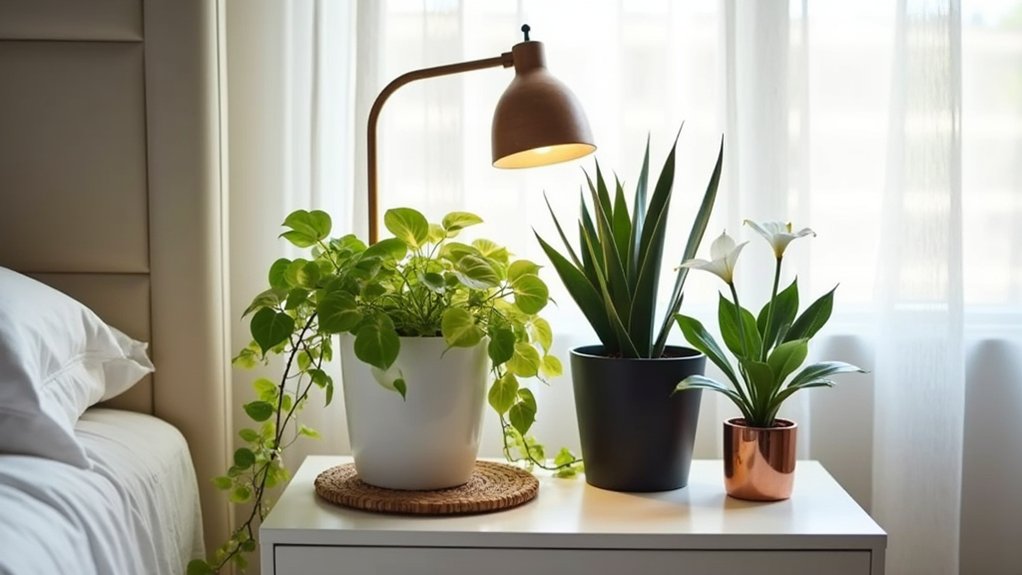
Styling your nightstand with air-purifying plants creates a serene and healthy sleeping environment while adding natural beauty to your bedroom decor. Popular choices like snake plants, peace lilies, and pothos not only complement bedside essentials but also work overtime to filter indoor air pollutants while you sleep.
These compact plants can be arranged in stylish containers that match your bedroom’s aesthetic, from sleek modern planters to vintage ceramic pots, creating an eye-catching display that’s both functional and decorative.
Growing Conditions:
- Light: Moderate to bright indirect light, though some varieties tolerate low light
- Water: Allow top inch of soil to dry between waterings
- Humidity: Average room humidity (40-60%)
- Temperature: 65-80°F (18-27°C)
- Soil: Well-draining potting mix with good aeration
- Container: Pots with drainage holes, sized appropriately for plant variety
Regular grooming and care will ensure your nightstand plants remain attractive and effective air purifiers. Dust leaves weekly with a soft, damp cloth to maintain their ability to filter air and photosynthesize efficiently.
Rotate plants quarterly to encourage even growth, and inspect regularly for signs of pests or disease. Trim yellowing or dead foliage promptly, and fertilize lightly during the growing season with a balanced, water-soluble fertilizer to maintain healthy growth without overwhelming your sleeping space with overly vigorous plants.
Hang Cascading Plants From Ceiling Corners
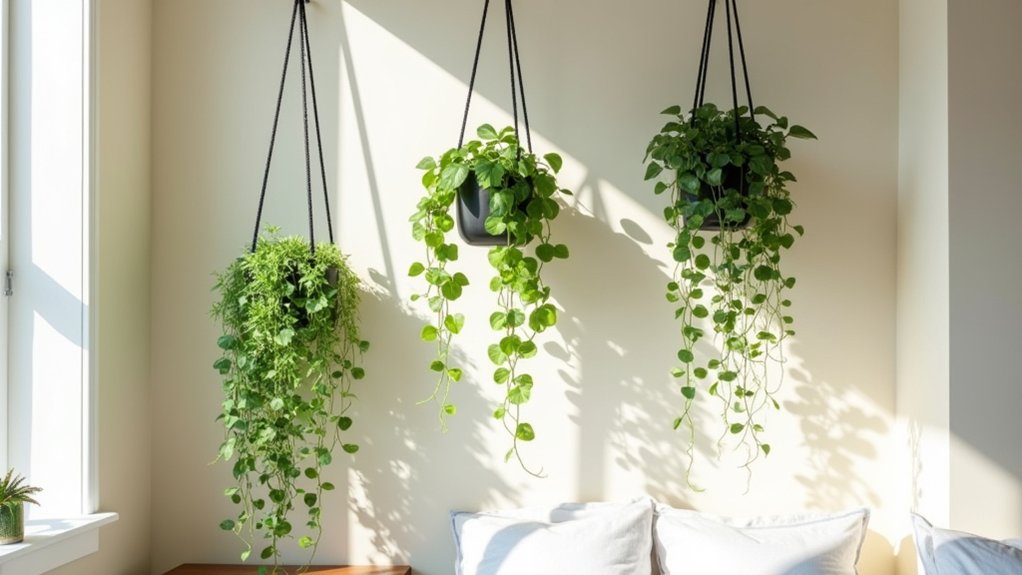
Cascading plants suspended from ceiling corners create a dramatic, waterfall-like effect that adds natural elegance to any bedroom. These trailing plants spill downward in graceful tendrils, softening harsh corners while maximizing vertical space.
Popular options include pothos, string of pearls, Boston ferns, and spider plants, which can grow several feet in length and create lush, living curtains of foliage that draw the eye upward while adding depth and dimension to the room.
- Light: Bright to moderate indirect light; avoid direct sunlight which can burn leaves
- Water: Allow top 1-2 inches of soil to dry between waterings
- Soil: Well-draining potting mix with good aeration
- Humidity: Moderate to high (50-60%)
- Temperature: 65-80°F (18-27°C)
- Container: Lightweight hanging planters with drainage holes
- Mounting: Secure ceiling hooks rated for plant and pot weight
Regular grooming and preventive care keep hanging plants looking their best and prevent potential issues.
Rotate containers quarterly to ensure even growth, trim yellowed or damaged vines, and dust leaves monthly with a damp cloth to maintain photosynthesis efficiency.
Check mounting hardware periodically for security, and place a drip tray or catch basin beneath plants when watering to protect flooring.
During growing seasons, fertilize with a balanced, water-soluble fertilizer every 4-6 weeks.
Design a Plant-Filled Window Nook
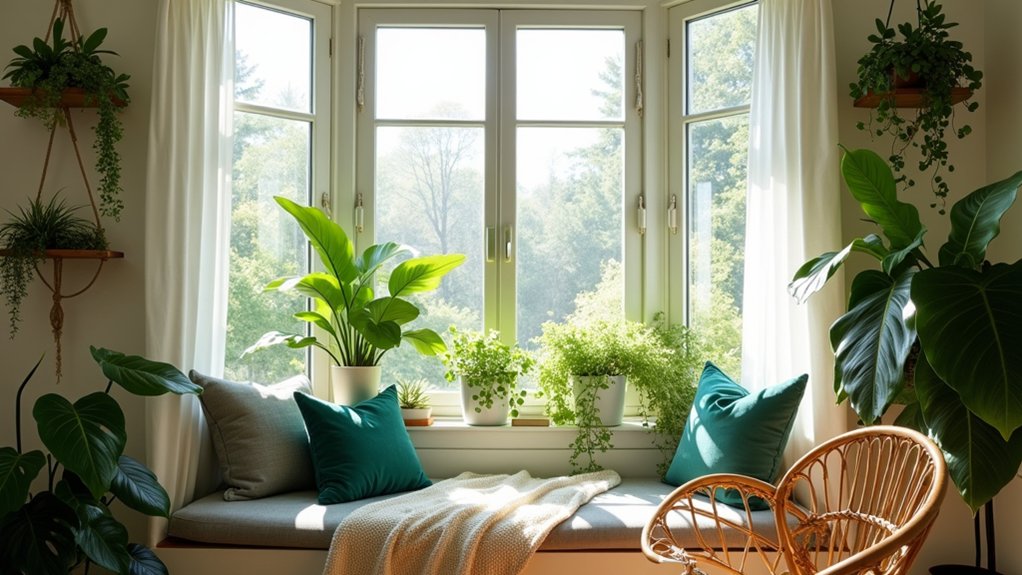
A plant-filled window nook transforms an ordinary bedroom corner into a lush, private retreat perfect for reading or relaxation. This cozy space typically features a comfortable bench or cushioned seating area nestled beneath a window, surrounded by an arrangement of plants at varying heights.
Hanging planters, floating shelves, and windowsill containers create a layered, garden-like atmosphere, while carefully selected plants with different textures and leaf shapes add visual interest. The nook can incorporate both trailing plants that cascade down walls and upright specimens that frame the window.
Growing Conditions:
- Position plants based on light requirements – shade-tolerant varieties further from window, sun-loving plants closer
- East or north-facing windows work best to avoid harsh afternoon sun
- Maintain room temperature between 65-80°F (18-27°C)
- Group plants with similar watering needs together
- Use well-draining potting soil appropriate for each plant type
- Ensure adequate air circulation between plants
- Consider humidity levels – use pebble trays or humidifier if needed
Maintaining a thriving window nook garden requires regular monitoring and adjustment. Rotate plants quarterly to ensure even growth and prevent them from permanently leaning toward the light.
Dust leaves monthly with a damp cloth to maximize light absorption and photosynthesis. Prune regularly to maintain desired shapes and remove any yellowing or dead foliage.
Watch for signs of pest infestation, especially in densely grouped plants, and treat immediately with appropriate methods. Adjust plant positioning seasonally to accommodate changing light patterns and intensity throughout the year.
Arrange a Tropical Paradise Behind Your Headboard
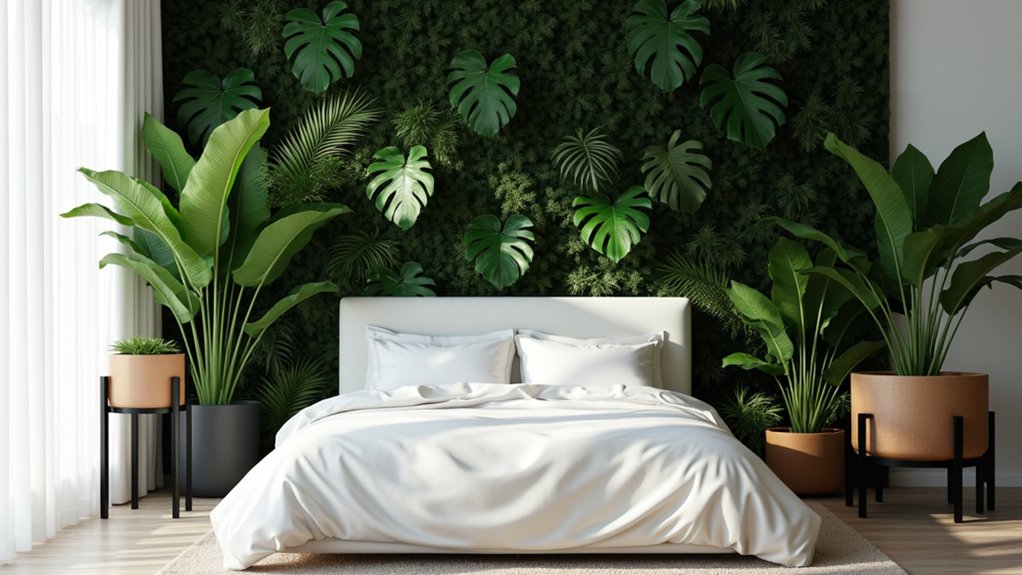
Creating a tropical paradise behind your headboard transforms your bedroom into an exotic retreat by arranging tall, leafy plants like bird of paradise, monstera, or palm varieties in varying heights.
Position larger plants directly behind the bed, with smaller specimens cascading down on either side to create a lush, layered effect. This living headboard not only serves as a striking focal point but also helps purify the air and adds natural humidity to the sleeping space.
- Light: Bright, indirect sunlight; avoid harsh afternoon sun
- Water: Keep soil consistently moist but not waterlogged
- Humidity: 60-80% relative humidity
- Temperature: 65-80°F (18-27°C)
- Soil: Well-draining, rich potting mix with organic matter
- Spacing: 2-3 feet between large plants for adequate air circulation
- Container: Large pots with drainage holes, at least 12 inches deep
Regular maintenance ensures your tropical backdrop remains vibrant and healthy.
Rotate plants quarterly to promote even growth, and dust leaves monthly with a damp cloth to maintain their glossy appearance and maximize photosynthesis.
Prune yellowing or dead foliage promptly to prevent disease spread, and check weekly for signs of pests, particularly under leaves and in plant crevices.
Group plants together on humidity trays filled with pebbles and water to maintain proper moisture levels without risking overwatering.
Transform Empty Corners With Floor-Standing Plants
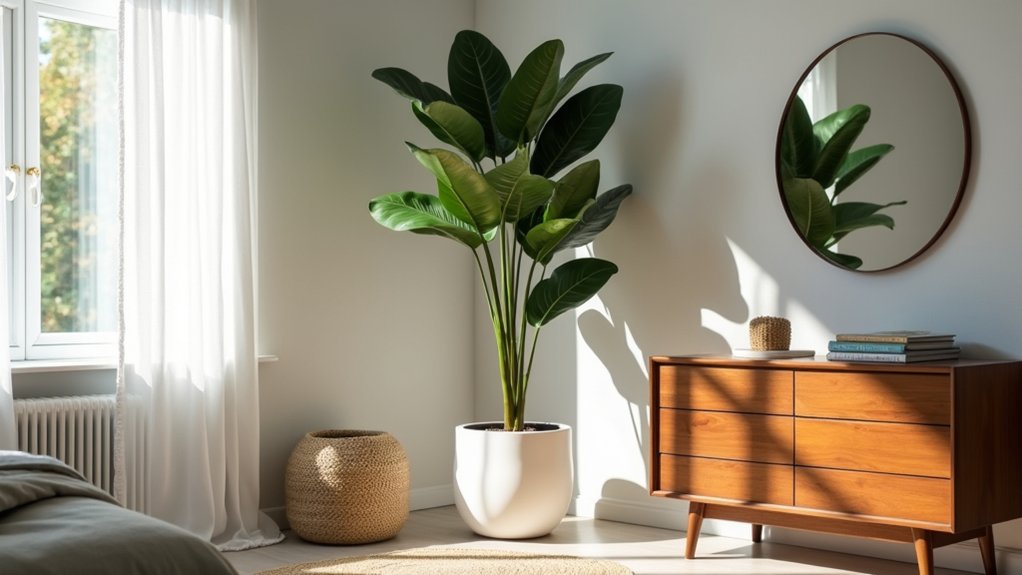
Floor-standing plants can magnificently transform empty corners into vibrant focal points while adding vertical interest to bedroom spaces. Large specimens like Fiddle Leaf Figs, Bird of Paradise, or Dracaena varieties create dramatic architectural statements, reaching heights of 4-6 feet or more.
These statement plants not only fill vertical space but also soften harsh corners with their organic shapes and create a natural transition between walls and furniture.
- Light: Bright, indirect sunlight; avoid direct afternoon sun that can scorch leaves
- Water: Allow top 1-2 inches of soil to dry between waterings
- Soil: Well-draining potting mix with good aeration
- Temperature: 65-80°F (18-27°C)
- Humidity: Moderate to high (40-60%)
- Container: Large pot with drainage holes, sized appropriately for plant height
- Support: Stakes or moss poles for climbing varieties
Regular dusting of leaves with a damp cloth maintains photosynthesis efficiency and appearance, while rotating the plant quarterly ensures even growth.
Prune yellowing or dead leaves promptly, and inspect for pests during weekly maintenance. As these plants grow taller, maintain stability by ensuring the pot is appropriately sized and weighted, possibly using decorative rocks on the soil surface for additional anchor support.
Mix Plants With Mirrors for Visual Impact
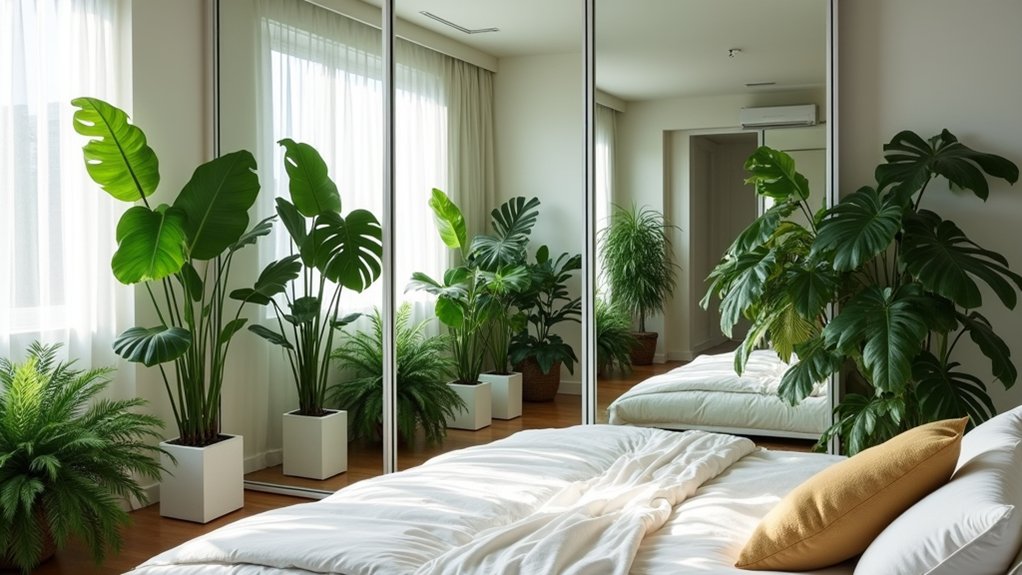
Combining plants with mirrors in bedroom decor creates a stunning visual effect that amplifies greenery while making spaces appear larger and more dynamic. Strategic placement of mirrors behind or adjacent to plants multiplies their reflection, creating the illusion of a more lush, garden-like atmosphere. This pairing works particularly well with trailing plants like pothos or string of pearls, where cascading foliage creates interesting layers of reflection, or with structural plants like snake plants whose strong vertical lines become bold architectural elements when multiplied in mirror reflections.
- Position plants where they receive appropriate natural light, as mirrors can’t substitute for direct sunlight needs.
- Ensure mirrors don’t focus intense reflected sunlight directly onto plant foliage.
- Place mirrors on walls adjacent to windows rather than directly opposite to maximize natural light distribution.
- Consider grouping plants with similar care requirements together near mirrors.
- Use clean, clear mirrors to maximize light reflection and visual impact.
- Allow adequate spacing between plants and mirrors to prevent moisture damage to mirror backing.
Regular maintenance of this design arrangement requires attention to both the plants and the mirrors. Clean mirror surfaces weekly with appropriate glass cleaner to maintain optimal reflection and remove any water spots or dust.
Rotate plants quarterly to ensure even growth on all sides, as plants naturally grow toward light sources and their reflection in mirrors may cause uneven growth patterns. When watering, take care to protect mirror frames and backing from moisture damage by moving plants to a sink or using drip trays, and promptly wipe any water splashes from mirror surfaces.
Build a Bedside Plant Shelf Gallery
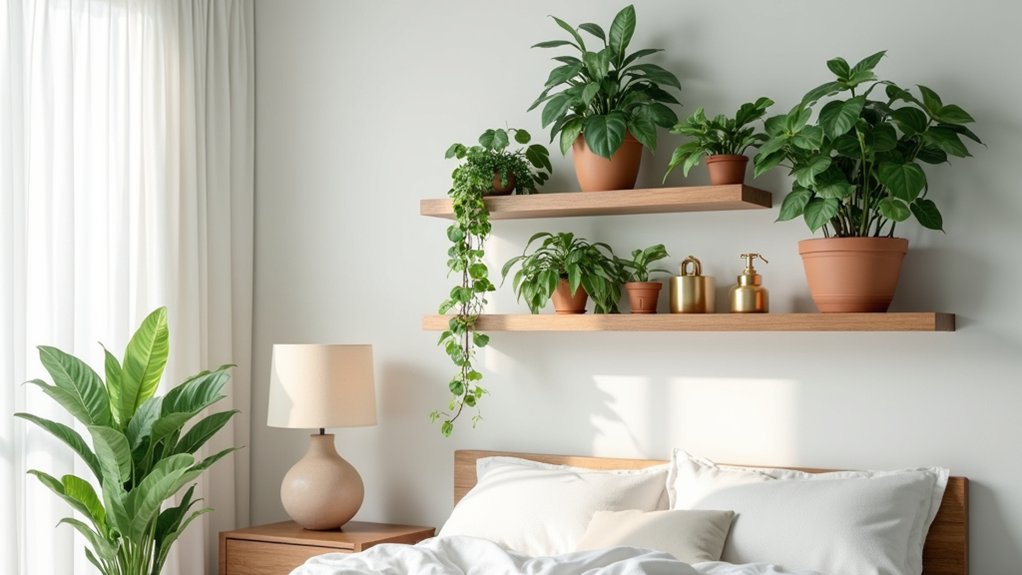
A bedside plant shelf gallery transforms your bedroom wall into a living display by combining floating shelves of varying lengths and heights to showcase a curated collection of plants. This vertical arrangement maximizes space while creating visual interest through different plant textures, sizes, and trailing vines.
The gallery typically features 3-5 shelves mounted at staggered heights, incorporating both deep and shallow shelf options to accommodate various pot sizes and plant growth habits.
- Light: Position gallery on a wall receiving medium to bright indirect light, avoiding direct afternoon sun
- Temperature: Maintain room temperature between 65-80°F (18-27°C)
- Humidity: Group plants together to create higher humidity levels
- Shelf Material: Use sturdy wood or metal shelves that can support wet pot weight
- Plant Selection: Mix low-light tolerant species (pothos, snake plants) with medium-light plants (peperomia, philodendrons)
- Spacing: Allow 8-12 inches between shelves for plant growth and maintenance access
Regular maintenance of a plant shelf gallery requires strategic rotation of plants to ensure even growth, as those closer to windows typically receive more light.
Dust shelves and plant leaves weekly to maximize light absorption and maintain aesthetics. Check shelf mounting regularly, especially when watering, to ensure weight distribution remains appropriate and structural integrity isn’t compromised by moisture.
Consider using cachepots or water-resistant trays under plants to protect shelving from water damage during care routines.
Layer Different Plant Heights for Depth and Drama
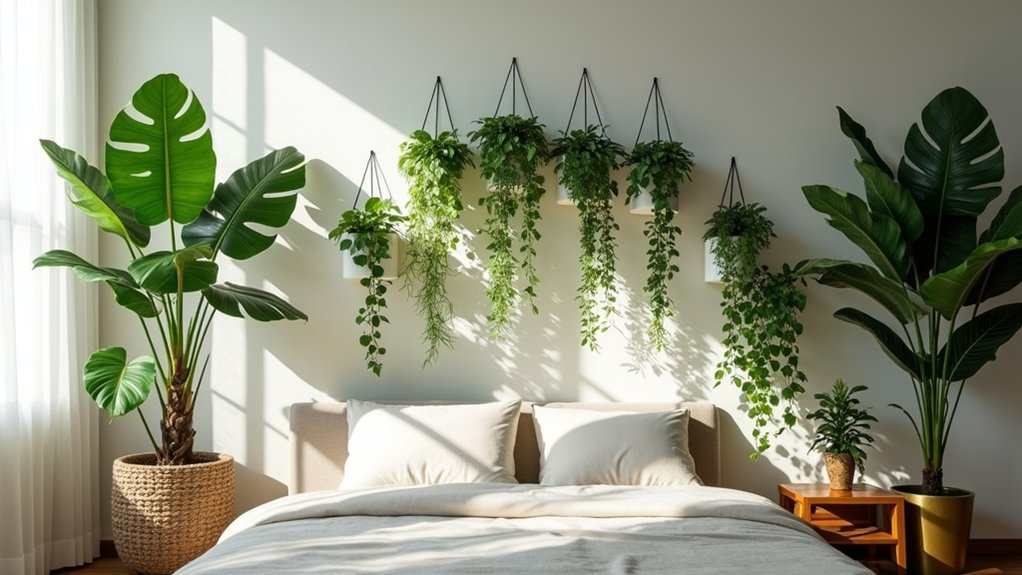
Creating visual interest through layered plant heights transforms a bedroom into a dynamic, nature-inspired space. By positioning plants at various elevations – from floor-standing specimens to hanging varieties and tabletop plants – you establish a lush, multi-dimensional effect that draws the eye through different levels of the room.
This arrangement technique mimics natural forest layers, with taller plants like fiddle leaf figs or palm trees serving as canopy elements, medium-sized plants like peace lilies creating a middle story, and trailing pothos or spider plants cascading from elevated surfaces.
Growing conditions for a layered plant display:
- Light requirements: Mix of plants tolerant to your room’s specific light conditions (bright indirect to low light)
- Temperature: Most indoor plants thrive in 65-80°F (18-27°C)
- Humidity: 40-60% humidity range, grouping plants together increases local humidity
- Spacing: Allow 1-2 feet between plants for proper air circulation
- Support: Sturdy shelving, plant stands, or hanging hardware rated for plant and pot weight
To maintain a healthy layered plant display, rotate plants quarterly to ensure even growth and prevent stretching toward light sources.
Regularly assess plant positions to accommodate growth and adjust heights as plants mature. Remove any yellowing or dead foliage promptly to maintain visual appeal and prevent disease spread between closely grouped plants.
Dust leaves monthly to maximize light absorption and maintain the aesthetic impact of the layered arrangement.
